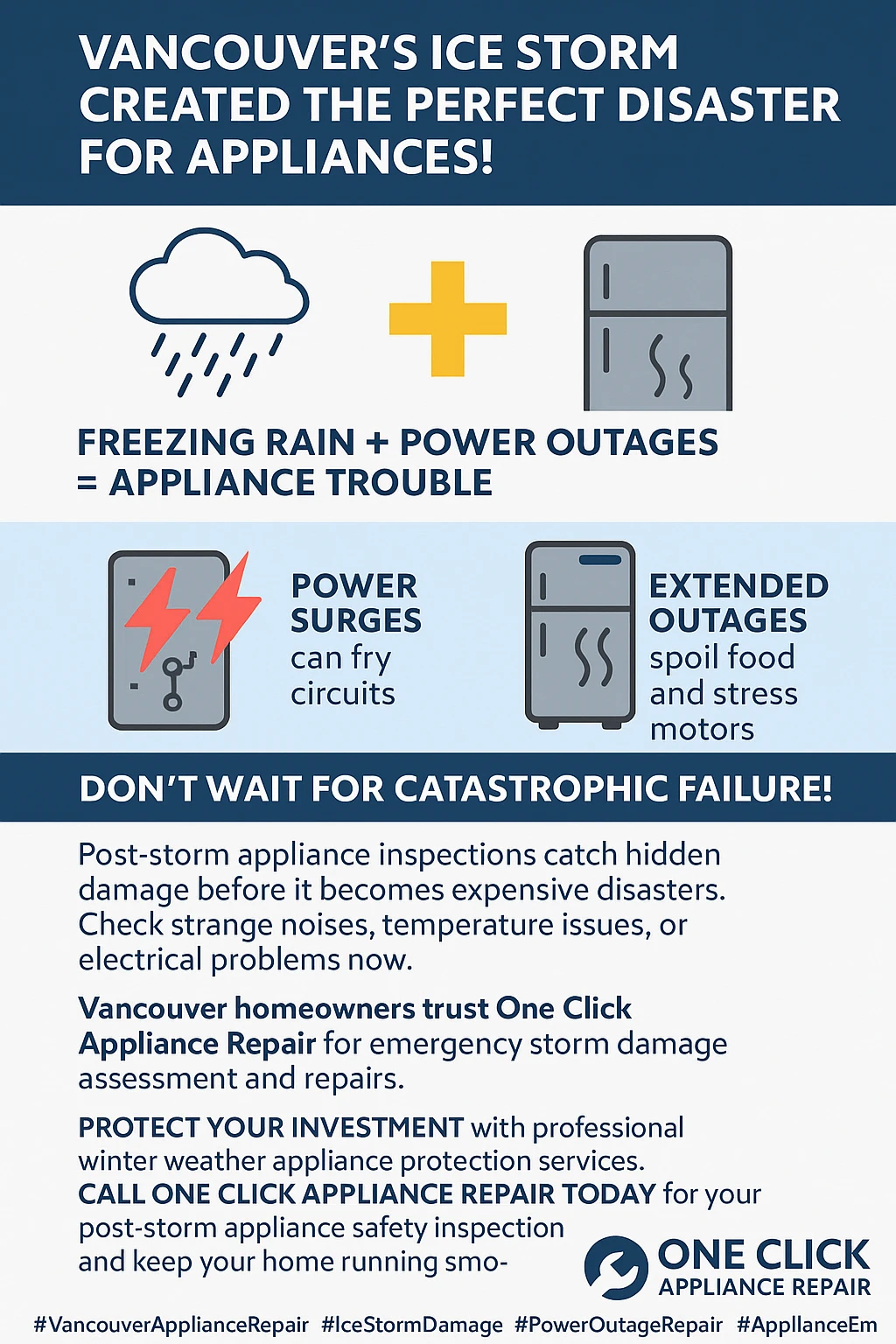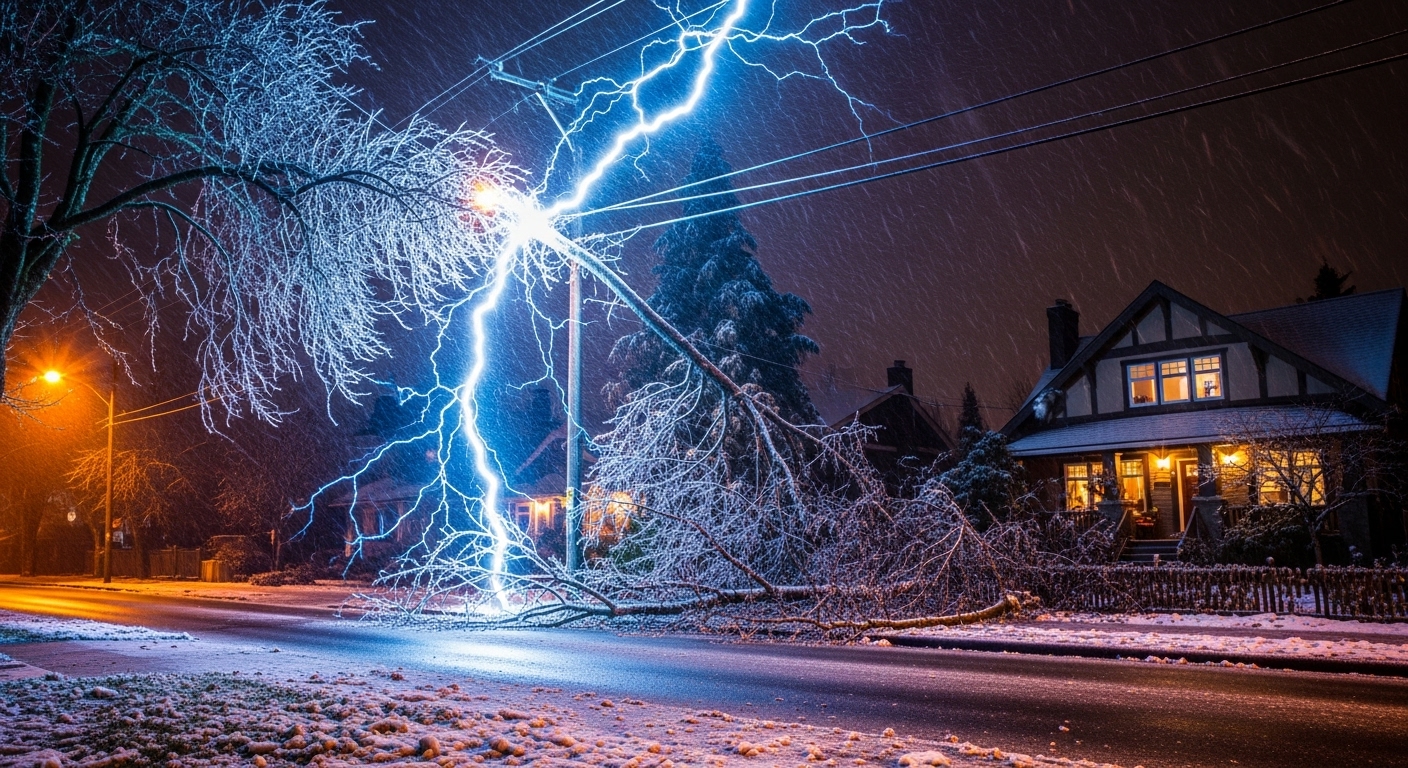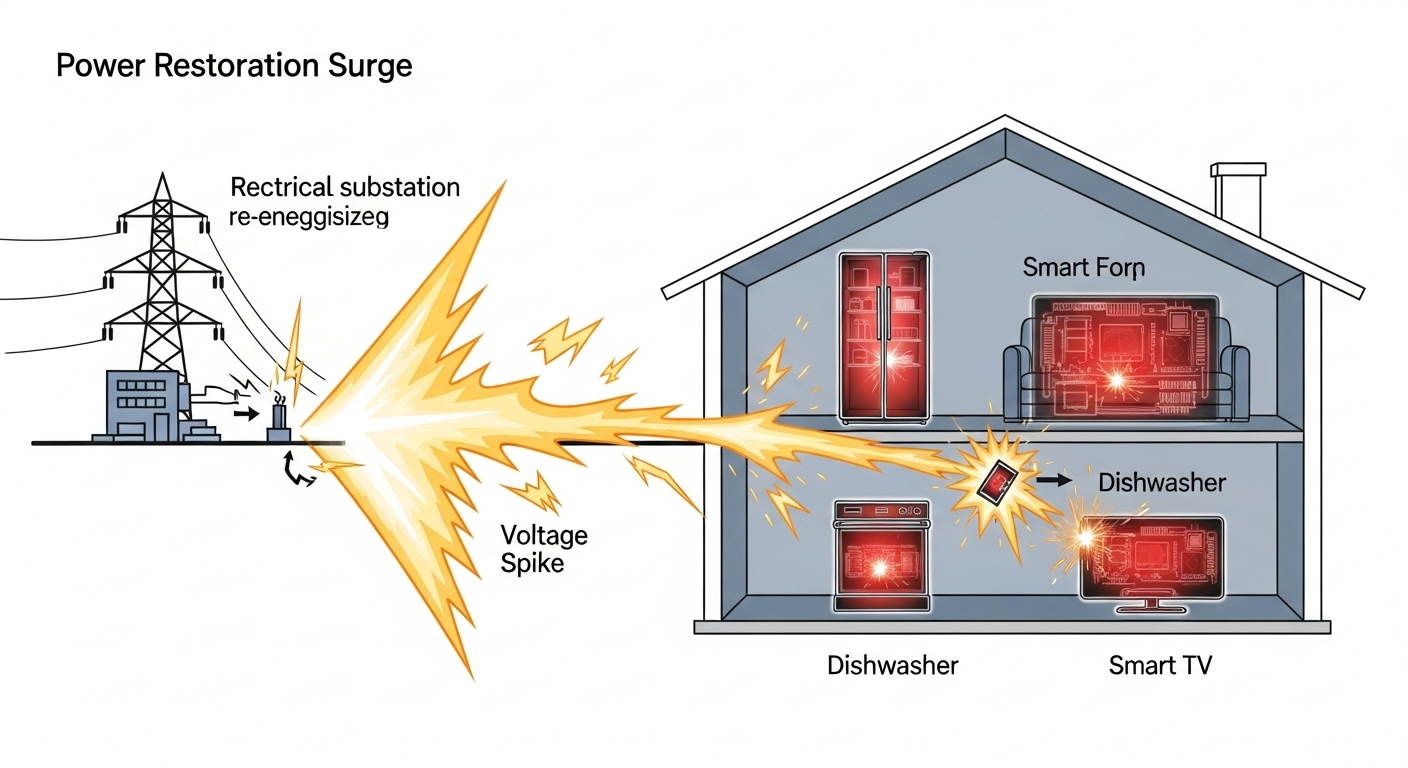Facing a mysterious electrical disaster after Vancouver’s latest ice storm where your expensive appliances are suddenly dead? You’re not alone – this perfect storm of freezing rain and power grid chaos is creating unprecedented appliance carnage across the Lower Mainland, and understanding what happened could save you thousands in unnecessary replacements. Picture this nightmare scenario: you’re hunkered down in your Vancouver home during one of those brutal November ice storms when suddenly there’s this massive “KABOOM” sound from outside, the lights flicker dramatically, and then everything goes black. Hours later, when BC Hydro finally gets the power back on, you discover that your smart fridge isn’t cooling, your dishwasher is displaying cryptic error codes, and your expensive Italian espresso machine is completely fried. This exact scenario just played out across North Vancouver’s Pemberton Heights neighborhood, where a single storm event caused an estimated $300,000 in appliance damage across just 33 homes. What makes Vancouver’s ice storm situation particularly devastating is how our unique coastal climate and aging electrical infrastructure create the perfect conditions for catastrophic appliance failures. The combination of freezing rain coating power lines, high winds bringing down tree branches, and our increasingly sophisticated smart home ecosystems creates a recipe for disaster that most homeowners never see coming. When temperatures plummet and ice accumulates on electrical infrastructure, even minor wind events can trigger cascading electrical failures that send destructive power surges racing through entire neighborhoods. The hidden truth about ice storm appliance damage is that most destruction doesn’t happen when the power goes out – it occurs when electricity gets restored. This phenomenon, called restoration surge, happens because utility crews essentially have to jumpstart entire neighborhood grids simultaneously, creating massive voltage spikes that can instantly fry delicate electronic components in modern appliances. Your Wi-Fi enabled refrigerator, smart washing machine, and computerized dishwasher are essentially sitting ducks for these electrical attacks.
Key Outtakes:
- Vancouver ice storms create dual-threat scenarios where freezing temperatures damage water-dependent appliances while power restoration surges destroy electronic components
- The November North Vancouver storm demonstrated how quickly damage escalates, with individual homeowners facing $8,000+ in appliance repairs from a single weather event
- Modern smart appliances prove exponentially more vulnerable to electrical damage than traditional mechanical appliances due to sensitive circuit boards and continuous connectivity
- Post-storm appliance inspection within 24-48 hours is critical for identifying damage, ensuring safety, and preserving insurance claim eligibility
- Whole-house surge protection systems could prevent 90%+ of electrical appliance damage during power restoration events

Understanding Vancouver’s Perfect Storm: How Ice and Electrical Infrastructure Create Appliance Disasters
 The recent Pemberton Heights incident perfectly illustrates how Vancouver’s unique geographic and climatic conditions create unprecedented vulnerability for household appliances. The combination of our coastal moisture, mature tree canopy, and aging electrical grid transforms routine winter storms into appliance-destroying catastrophes that can devastate entire neighborhoods within hours. What residents described as hearing a loud “boom” or “kaboom” before losing power indicates the exact moment when electrical infrastructure failed catastrophically, sending chaotic voltage spikes through connected homes before protective systems could respond. BC Hydro confirmed that trees contacting power lines directly caused the transformer damage in this specific incident, which represents the most common trigger for surge-related appliane damage across the Lower Mainland. Vancouver’s dense urban forest creates beautiful neighborhoods, but those same mature trees become electrical hazards during ice storms when accumulated ice weighs down branches and high winds bring them into contact with live power lines. When branches or entire trees fall onto electrical infrastructure, they create instantaneous electrical faults that send unpredictable voltage spikes racing through the distribution system faster than traditional circuit breakers can detect and respond. The financial exposure for average Vancouver households has grown dramatically as modern homes now contain approximately $15,000 worth of surge-sensitive electronics and appliances. This represents a fundamental shift from previous generations of household equipment that relied primarily on simple mechanical switches and manual controls. Today’s appliances are essentially computers disguised as household equipment, containing sophisticated circuit boards, processors, and communication systems that require precise voltage regulation to function safely. Even modest voltage fluctuations outside normal operating ranges can permanently damage these delicate internal components, often requiring complete appliance replacement rather than simple repairs. Vancouver’s coastal climate introduces additional complications that accelerate appliance vulnerability during winter weather events. Salt air gradually corrodes electrical connections throughout home wiring systems, making appliances less capable of handling electrical stress effectively. High humidity levels typical of the Pacific Northwest create moisture infiltration challenges for appliance control boards and electrical components, even in the absence of direct water exposure. The frequent freeze-thaw cycles that characterize Vancouver winters put additional mechanical stress on appliance components, weakening seals, gaskets, and connection points that become more vulnerable to failure during electrical surge events.
The recent Pemberton Heights incident perfectly illustrates how Vancouver’s unique geographic and climatic conditions create unprecedented vulnerability for household appliances. The combination of our coastal moisture, mature tree canopy, and aging electrical grid transforms routine winter storms into appliance-destroying catastrophes that can devastate entire neighborhoods within hours. What residents described as hearing a loud “boom” or “kaboom” before losing power indicates the exact moment when electrical infrastructure failed catastrophically, sending chaotic voltage spikes through connected homes before protective systems could respond. BC Hydro confirmed that trees contacting power lines directly caused the transformer damage in this specific incident, which represents the most common trigger for surge-related appliane damage across the Lower Mainland. Vancouver’s dense urban forest creates beautiful neighborhoods, but those same mature trees become electrical hazards during ice storms when accumulated ice weighs down branches and high winds bring them into contact with live power lines. When branches or entire trees fall onto electrical infrastructure, they create instantaneous electrical faults that send unpredictable voltage spikes racing through the distribution system faster than traditional circuit breakers can detect and respond. The financial exposure for average Vancouver households has grown dramatically as modern homes now contain approximately $15,000 worth of surge-sensitive electronics and appliances. This represents a fundamental shift from previous generations of household equipment that relied primarily on simple mechanical switches and manual controls. Today’s appliances are essentially computers disguised as household equipment, containing sophisticated circuit boards, processors, and communication systems that require precise voltage regulation to function safely. Even modest voltage fluctuations outside normal operating ranges can permanently damage these delicate internal components, often requiring complete appliance replacement rather than simple repairs. Vancouver’s coastal climate introduces additional complications that accelerate appliance vulnerability during winter weather events. Salt air gradually corrodes electrical connections throughout home wiring systems, making appliances less capable of handling electrical stress effectively. High humidity levels typical of the Pacific Northwest create moisture infiltration challenges for appliance control boards and electrical components, even in the absence of direct water exposure. The frequent freeze-thaw cycles that characterize Vancouver winters put additional mechanical stress on appliance components, weakening seals, gaskets, and connection points that become more vulnerable to failure during electrical surge events.
The Dual Destruction Process: How Power Outages Transform Into Appliance-Killing Electrical Attacks
 Understanding the mechanics of how power restoration creates appliance-destroying conditions requires recognizing that the most critical damage typically occurs not when electricity goes out, but when power gets restored to affected areas. This restoration surge phenomenon happens because utility crews must re-energize entire neighborhood electrical grids simultaneously, essentially jumpstarting massive distribution systems that have been completely de-energized. The process of bringing these systems back online creates enormous voltage spikes that can overwhelm residential electrical systems within milliseconds, traveling through home wiring faster than traditional protective devices can respond. In the North Vancouver incident, residents described the sequence of events that perfectly illustrates this dual-destruction process. The initial transformer explosion sent chaotic electrical surges through connected neighborhoods before safety systems could isolate the damaged equipment. When power was eventually restored several hours later, the utility’s re-energization process created additional massive voltage spikes that randomly damaged appliances throughout the affected area. One local electrician explained to affected homeowners that 240-volt power had surged through 120-volt lines, creating conditions where these distribution lines simply “can’t handle it, and that’s why it randomly kills appliances.” This technical explanation captures the fundamental problem with restoration surges: they push voltage levels far beyond what residential distribution systems and household appliances are designed to handle. Modern smart appliances prove particularly vulnerable because their sophisticated electronic control systems operate at much lower voltages than traditional mechanical appliances. Your Wi-Fi-enabled refrigerator contains circuit boards and processors that require precise voltage regulation to function properly. When restoration surges overwhelm these delicate components, damage occurs instantly and permanently – burned-out compressor controls, fried circuit boards, and destroyed communication modules that cannot be repaired economically. The randomness of surge damage across affected neighborhoods demonstrates the chaotic nature of these electrical events. One home might lose its refrigerator, stove, and dishwasher while a neighboring residence experiences damage only to the television and Wi-Fi router. This unpredictable damage pattern reflects the complex interplay of which appliances were actively connected at the precise moment surge energy passed through each home’s electrical system, how effectively each home’s electrical panel could dissipate surge energy, and the specific voltage tolerances of individual appliance components. Business owners face particularly devastating impacts when restoration surges strike during operational hours. The Pemberton Heights restaurant owner faced emergency repair bills totaling $5,000-$6,000 just to keep her business operational, with additional costs anticipated for ongoing repairs. Her Italian espresso machine, walk-in refrigerator, blenders, ice machine, and lighting systems all suffered simultaneous damage, forcing immediate emergency repairs to prevent total business shutdown. This represents the scale of financial impact that restoration surges can create within minutes of power being restored.
Understanding the mechanics of how power restoration creates appliance-destroying conditions requires recognizing that the most critical damage typically occurs not when electricity goes out, but when power gets restored to affected areas. This restoration surge phenomenon happens because utility crews must re-energize entire neighborhood electrical grids simultaneously, essentially jumpstarting massive distribution systems that have been completely de-energized. The process of bringing these systems back online creates enormous voltage spikes that can overwhelm residential electrical systems within milliseconds, traveling through home wiring faster than traditional protective devices can respond. In the North Vancouver incident, residents described the sequence of events that perfectly illustrates this dual-destruction process. The initial transformer explosion sent chaotic electrical surges through connected neighborhoods before safety systems could isolate the damaged equipment. When power was eventually restored several hours later, the utility’s re-energization process created additional massive voltage spikes that randomly damaged appliances throughout the affected area. One local electrician explained to affected homeowners that 240-volt power had surged through 120-volt lines, creating conditions where these distribution lines simply “can’t handle it, and that’s why it randomly kills appliances.” This technical explanation captures the fundamental problem with restoration surges: they push voltage levels far beyond what residential distribution systems and household appliances are designed to handle. Modern smart appliances prove particularly vulnerable because their sophisticated electronic control systems operate at much lower voltages than traditional mechanical appliances. Your Wi-Fi-enabled refrigerator contains circuit boards and processors that require precise voltage regulation to function properly. When restoration surges overwhelm these delicate components, damage occurs instantly and permanently – burned-out compressor controls, fried circuit boards, and destroyed communication modules that cannot be repaired economically. The randomness of surge damage across affected neighborhoods demonstrates the chaotic nature of these electrical events. One home might lose its refrigerator, stove, and dishwasher while a neighboring residence experiences damage only to the television and Wi-Fi router. This unpredictable damage pattern reflects the complex interplay of which appliances were actively connected at the precise moment surge energy passed through each home’s electrical system, how effectively each home’s electrical panel could dissipate surge energy, and the specific voltage tolerances of individual appliance components. Business owners face particularly devastating impacts when restoration surges strike during operational hours. The Pemberton Heights restaurant owner faced emergency repair bills totaling $5,000-$6,000 just to keep her business operational, with additional costs anticipated for ongoing repairs. Her Italian espresso machine, walk-in refrigerator, blenders, ice machine, and lighting systems all suffered simultaneous damage, forcing immediate emergency repairs to prevent total business shutdown. This represents the scale of financial impact that restoration surges can create within minutes of power being restored.
Ice Storm Freeze Damage: The Secondary Threat to Water-Dependent Appliances
 While electrical surges capture immediate attention due to their dramatic and instantaneous effects, Vancouver ice storms simultaneously create a second dimension of appliance vulnerability through freezing temperatures that damage water-dependent systems. Dishwashers, washing machines, and refrigerators with ice makers and water dispensers face significant risk when temperatures drop below freezing for extended periods. Water trapped within these appliances’ internal pipes, valves, and supply lines begins to freeze and expand, creating tremendous pressure within confined spaces that often results in burst pipes, cracked valves, and damaged internal seals. The North Vancouver storm occurred during winter conditions when ambient temperatures dropped sufficiently to create freezing conditions in unheated spaces where appliance water lines are commonly installed. Dishwashers prove particularly vulnerable because their water supply connections often run through exterior walls or unheated crawl spaces where temperatures can drop below freezing even when indoor living spaces remain comfortable. When water within these supply lines freezes, the expanding ice creates pressure that can crack intake valves and develop leaks that may not become immediately apparent to homeowners. Washing machines face similar freeze-damage risks, complicated by the fact that these appliances typically contain residual water in drain lines and pump systems even when not actively operating. Water trapped in drainage pumps or discharge hoses can freeze during extended cold periods, then expand and crack components that only reveal damage when the appliance operates again. When frozen water blocks drain lines completely, washing machines cannot discharge
While electrical surges capture immediate attention due to their dramatic and instantaneous effects, Vancouver ice storms simultaneously create a second dimension of appliance vulnerability through freezing temperatures that damage water-dependent systems. Dishwashers, washing machines, and refrigerators with ice makers and water dispensers face significant risk when temperatures drop below freezing for extended periods. Water trapped within these appliances’ internal pipes, valves, and supply lines begins to freeze and expand, creating tremendous pressure within confined spaces that often results in burst pipes, cracked valves, and damaged internal seals. The North Vancouver storm occurred during winter conditions when ambient temperatures dropped sufficiently to create freezing conditions in unheated spaces where appliance water lines are commonly installed. Dishwashers prove particularly vulnerable because their water supply connections often run through exterior walls or unheated crawl spaces where temperatures can drop below freezing even when indoor living spaces remain comfortable. When water within these supply lines freezes, the expanding ice creates pressure that can crack intake valves and develop leaks that may not become immediately apparent to homeowners. Washing machines face similar freeze-damage risks, complicated by the fact that these appliances typically contain residual water in drain lines and pump systems even when not actively operating. Water trapped in drainage pumps or discharge hoses can freeze during extended cold periods, then expand and crack components that only reveal damage when the appliance operates again. When frozen water blocks drain lines completely, washing machines cannot discharge

